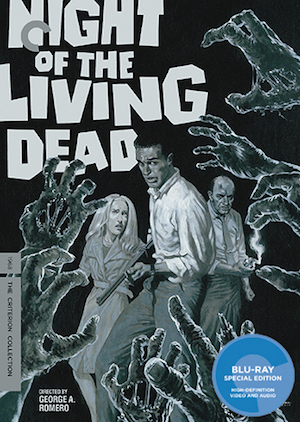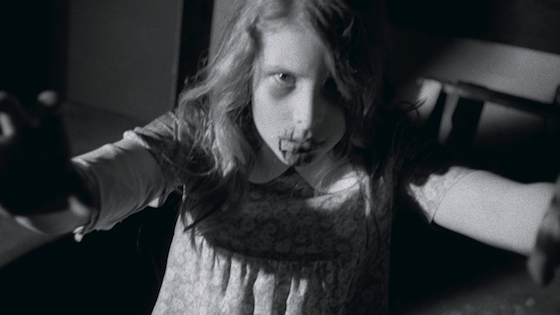When it comes to hugely influential independent movies, few can lay claim to having the influence of George Romero‘s 1968 labor of love Night of the Living Dead. In a new bonus featurette included on the new 2-disc Blu-ray of the film from The Criterion Collection, director Guillermo del Toro says “George went to the id of America.”
Frank Darabont (The Shawshank Redemption) calls Night of the Living Dead something “far greater than the sum of its parts” and “one of the faces on Mount Rushmore of this idea.” This idea being that a passionate group of people with little budget (in this case around $117,000) could create something exciting and wholly original by creating a novel premise and respecting it; taking it as seriously as possible.
Yes, this is ground zero for the zombie film (even though the walking dead in this movie are referred to as ghouls). And because it’s been in the public domain almost since the moment it was released in drive-ins all over the country,* every version the public has seen since then has been a dub of a dub or worse. This new 4K digital restoration (made possible by the Film Foundation and Museum of Modern Art) marks the first time Night of the Living Dead has been seen and heard with such clarity, and its easy to see why the film was so influential.
50 years later, it is still a shock to the system.
Romero and his crew from Pittsburgh made their living as indie production company The Latent Image, specializing in commercials and industrial films. Many of these show up on the second disc of extras, and one of the most obvious links between their work-for-hire and this historic horror flick is the kinetic energy of the close-ups, cutting on action, and the off-kilter framing of bodies and faces. Romero not only directed Night of the Living Dead, but he also shot and edited it. He cut his teeth at his day job and he was used to a high level of control. His debut film as a director is the very definition of a vision realized, even if Romero says (in a 2012 TIFF interview that’s also included in this package) that when he watches it, all he sees are the mistakes.
Sure, the soundtrack is completely made up of existing “library music” and there are cuts that cross the 180° line, but Romero’s instincts were correct about so many things. He shot on 35mm black and white because he felt it would mirror news footage and provide a necessary link to realism. Using news footage in the film reinforces this, as well as the movie’s rural setting and its claustrophobia. It was so real for del Toro that he remembers the movie as a nightmare.
Up until then, the horror entity that audiences knew as “zombies” always had some sort of otherworldly voodoo connection. Romero removed that and created the modern zombie rules that are, by now, understood as fact by the modern world: A bite infects you, ghouls have an everlasting hunger for flesh, and they can only be killed by destroying their brains or burning their bodies.
The metaphor of Night of the Living Dead also emerges (pardon the pun) fully fleshed out. In maybe the most horrifying scene, an infected daughter attacks her father and begins eating him in front of her mother. This was Romero’s comment on what he saw in society as a serious disintegration of the family unit.
The influential French film journal Cahiers du Cinéma famously held up the movie for its radical racial component. The main character in the film – the one who is smarter, more agile, and has the firmest moral compass of anyone – is an African-American man. (Romero also says in the TIFF interview that was pure chance. Black actor Duane Jones was a friend from college, and simply the best actor they knew.) He saves a white woman from the ghouls, plus he berates and smacks around a white guy for being a coward, and at the end … well you’ve had 50 years to see it, but lets just say the ending is Romero’s final blow to a hypocritical value system. Martin Luther King Jr. was assassinated after the film had been shot, and just six months before its premiere, so this ugly cloud was still very much hanging over audiences of the time and certainly made it more disturbing and timely.
Romero’s intention was to tap into the radical societal changes of the time, but many critics of the film at the time just saw how he pushed the envelope on gore. And he does, for sure. Del Toro claims its the first movie to show viscera; people eating flesh. It’s tame of course by todays’ standards, but that, combined with he cynical racial component, was viewed as an all-out attack on “civilized” American society in general.
Without going too deeply into all of the supplements, which include two audio commentaries, rare footage from the dailies, new interviews, video essays, and archival interviews, let’s just say that The Criterion Collection’s Night of the Living Dead double-disc Blu-ray is, hands down, the long-deserved deluxe edition that this movie has deserved for so long.
* The film’s original title was Night of the Flesh-Eaters and it was accidentally copyrighted that way and never revised after the name change and before its release. It was also called Night of Anubis at one point and a workprint of that version of the film appears on Disc One of the Criterion Blu-ray.











Comments on this entry are closed.